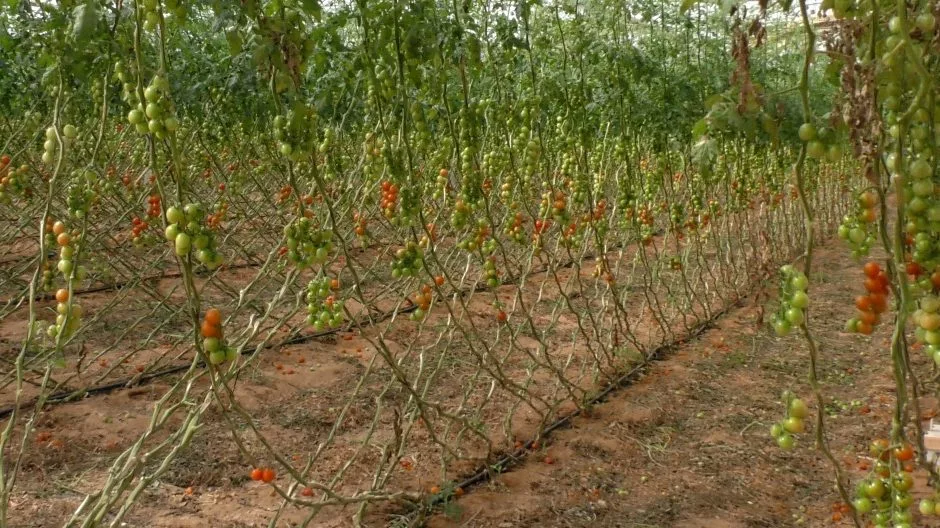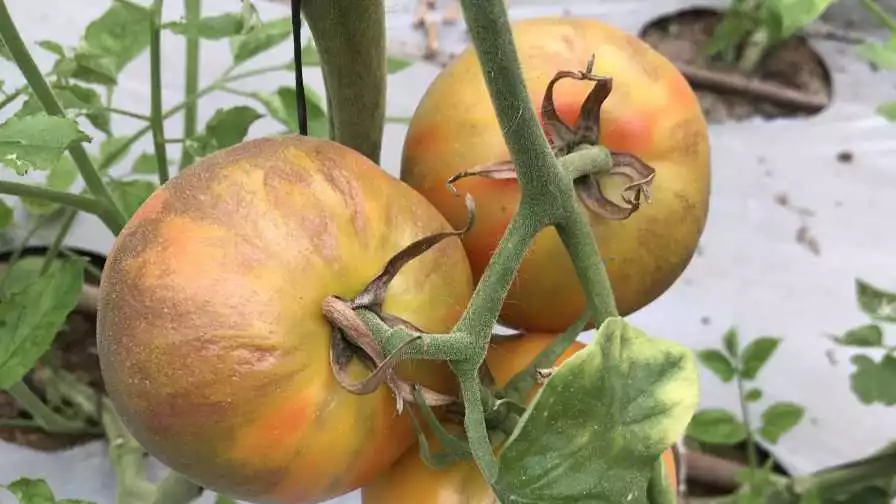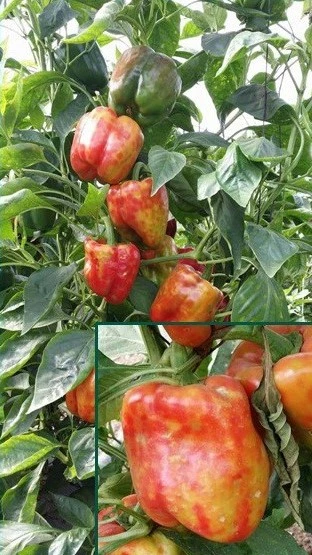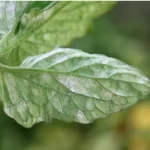What is ToBRFV?
Tomato brown rugose fruit virus, commonly known as ToBRFV, is a virus belonging to the genus Tobamovirus. This virus has been around since 2014, when it was first discovered in Israel [1]. Although it is too early to estimate global crop production damage, data gathered from Florida, USA showed an estimated 30% – 70% yield loss yearly. This accounts for $262 million USD a year in economic impact [2].
You may be familiar with other viruses belonging to this genus such as tobacco mosaic virus, pepper mild mottle virus, and various other ringspot, mottle and mosaic viruses with different plant targets. Tobamoviruses typically target plants belonging to the Brassicaceae (e.g. cabbage, broccoli, kale), Cucurbitaceae (e.g. cucumbers, melons, squash, gourds), Malvaceae (e.g. cotton, cacao, hibiscus) and Solanaceae (e.g. peppers, tomato, eggplant, peppers, tobacco) families.
ToBRFV can cause severe fruit loss in tomatoes and peppers. On pepper, it causes bubbling and mosaic patterns on leaves. While on tomatoes, it causes mosaic patterns on leaves and a “fern leaf” symptom. Infected fruits of both hosts are smaller, discolored, and may have rough, dead patches on the surface. For infected tomato fruits, this means reduced quality and lower likelihood to be bought [3].

Infection and Symptoms:
ToBRFV is a highly contagious, very aggressive virus that can cause serious infection on tomatoes and peppers. ToBRFV is transmitted in seeds and spreads easily when healthy plants come in contact with contaminated equipment, hands, clothing, or infected plants or plant parts. When it comes to contaminated equipment, the virus can survive anywhere from weeks to months, according to the American Seed Trade Association[4]. Since this virus is difficult to control and eradicate, prevention and early detection are important in order to protect crops [5].
It is important to note that ToBRFV cannot just be exclusively detected through visual inspection and not all plants will display symptoms [5]. Lab testing needs to be completed in order to confirm infection on both tomato and pepper plants. However, when a plant does show symptoms of ToBRFV, the leaves exhibit a mild to severe yellow mosaic pattern, wrinkling, mottling, and occasional narrowing. Fruits will display yellow, brown, and necrotic areas and can be rough and deformed [1] (Figure 2). In peppers, fruits display similar symptoms but can also exhibit green grooves (Figure 3) [1].

We will cover more pathogens in future blogs. Stay updated by subscribing to our newsletter.
Growth Conditions:
The ideal growth conditions for the virus is any place where the spread of the virus can occur very readily by mechanical transfer. This means that times when plants are pruned, staked, handled and touched frequently are times of higher risk for infection of ToBRFV. In an open field, the spread of this virus often includes machinery used for cultivation or weed control as it allows the virus to spread easily from plant to plant. An often underestimated but important risk of contamination is the irrigation water.
How to control ToBRFV in your hydroponic system:
One of the best ways to prevent the spread of ToBRFV is to ensure you have the best cultural practices, as there are no chemicals that can help cure infected plants. Here are five of the best practices to use in your greenhouse to avoid spread of ToBRFV in your crops [6]:
- Use seeds that have been tested as “free from ToBRFV” by an officially recognised method
- Allow only the necessary people to enter the place of production or join the visit
- Wash hands with soap on arrival and departure from the production site and between the business units (greenhouse, canteen, toilets, etc)
- Inspect the plants regularly. If symptomatic plants are discovered, eliminate all plants within a minimum of 1.5 meters beyond the outermost infected plant
- All containers that hosted infested plants must be sterilized or destroyed. All infected plants, debris and contaminated substrate shall be removed and incinerated
ToBRFV in hydroponic systems:
Although ToBRFV is present in tomato and pepper plants in hydroponic systems, it is less of a threat [7]. This is due to the fact that the main point of transmission is through contact in both tomato and pepper plants. Transmission is less significant through water circulation systems in hydroponic crops. However, it can still affect hydroponic crops through seed transmission, as a single seed-infected plant is sufficient for subsequent mechanical transmission throughout the plantation [7].

Why the recent and severe emergence of ToBRFV?
ToBRFV was first discovered in Israel in 2014, and just like any other virus without a solution, it can spread like wildfire! In recent years, ToBRFV has been identified in at least a dozen other countries, including the United States and Canada[8]. Today, ToBRFV produces a threat to the productivity of tomato and pepper plants on a global scale. The reason that it is of such high concern is because it is able to overcome the resistance gene Tm-22 which is used commonly by breeders in the construction of tomato hybrids that are created for protected cultivation [8]. This means that this gene provides protection against other Tobamoviruses and is not effective in protecting crops against ToBRFV. The novelty of this virus and the ability to impact crops easily makes ToBRFV a unique and dangerous virus to tomato and pepper crops.
Pathogen Profile provides a concise summary of a plant pathogen that growers are interested in. See our Resource page to see what we aim to cover in each post.
Disclaimer:
The information we present in Pathogen Profile is based on collating published peer-reviewed scientific literature and sources we think are reliable. This is by no means an exhaustive review of pathogens. Pathogen Profile gives a small glimpse of what is known about pathogens and we encourage growers to do more research on their own based on the pathogens in relation to their own crops and hydroponic systems. The information presented in Pathogen Profile are for educational purposes and should not be used as professional advice to treat pathogens or to operate your hydroponic system.
References
[1]Save the Tomato: Israeli Scientists Fight Devastating Plant Disease – The Media Line. (n.d.). Retrieved April 8, 2022, from https://themedialine.org/life-lines/save-the-tomato-israeli-scientists-fight-devastating-plant-disease/
[2]Klap, C., Luria, N., Smith, E., Bakelman, E., Belausov, E., Laskar, O., Lachman, O., Gal-On, A., & Dombrovsky, A. (2020). The Potential Risk of Plant-Virus Disease Initiation by Infected Tomatoes. Plants, 9(5), 623. https://doi.org/10.3390/plants9050623
[3]Goldy, R. (2019, November 25). Tomato brown rugose fruit virus (ToBRFV): A new concern for tomato and pepper producers. Michigan State University Extension. https://www.canr.msu.edu/news/tobrfv-a-new-concern-for-tomato-and-pepper-producers
[4] American Seed Trade Association. (n.d.). Q&A ON THE NEW TOBAMOVIRUS: TOMATO BROWN RUGOSE FRUIT VIRUS (ToBRFV). Retrieved April 12, 2022, from https://www.betterseed.org/wp-content/uploads/ToBRFV-QA.pdf
[5]Animal and Plant Inspection Service. (2021). Survey and Response Plan Tobamovirus: Tomato Brown Rugose Fruit Virus (ToBRFV) . https://www.aphis.usda.gov/import_export/plants/plant_imports/tobrfv/tobrfv-survey-and-response-plan.pdf
[6]Tomato Brown Rugose Fruit Virus. (n.d.).
[7]Authorities in the Region of Murcia detected the first case of ToBRFV in Spain since 2019. (n.d.). Retrieved April 8, 2022, from https://www.freshplaza.com/article/9359941/authorities-in-the-region-of-murcia-detected-the-first-case-of-tobrfv-in-spain-since-2019/
[8]Rizzo, D., da Lio, D., Panattoni, A., Salemi, C., Cappellini, G., Bartolini, L., & Parrella, G. (2021). Rapid and Sensitive Detection of Tomato Brown Rugose Fruit Virus in Tomato and Pepper Seeds by Reverse Transcription Loop-Mediated Isothermal Amplification Assays (Real Time and Visual) and Comparison With RT-PCR End-Point and RT-qPCR Methods. Frontiers in Microbiology, 12, 773. https://doi.org/10.3389/FMICB.2021.640932
Looking for more useful info? Go back to the Blog Page or checkout the Resources Page.
![]()
Tanya Irani is a bioinformatics specialist at Healthy Hydroponics




